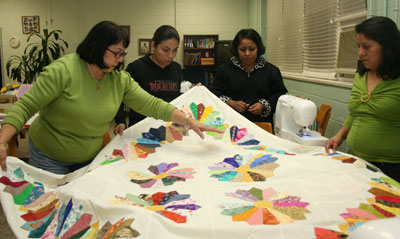
 The front room of the parish hall at St. Cyprian Church in Georgetown transforms into a riot of color on Monday nights.
The front room of the parish hall at St. Cyprian Church in Georgetown transforms into a riot of color on Monday nights.
Brilliantly hued bolts, squares and strips of fabric take over every surface, accompanied by the whir of sewing machines and a constant, excited stream of conversation, most of it in Spanish.
Since 2009, the parish has offered quilting classes for the Hispanic community. Each week, a dedicated group of people show up to create beautiful quilts and for friendship and spiritual support.
Two volunteers, Elva Horlings and Marilyn Sholtis, started the classes as a way to combine their love of sewing and a desire to help their community.
Horlings, who is originally from Texas and has Mexican and Spanish ancestry, is bilingual and realized she might be able to offer something especially for the large Hispanic community that attends St. Cyprian.
The sessions attract mainly women, all from Mexico.
“Many of our students have never even sat at a sewing machine before they come here, so we start with simple straight stitching, learning how to measure fabric, thread a machine and work a pedal,” said Horlings, who attends Precious Blood of Christ Church on Pawleys Island.
 “It starts out like sewing 101, but then they make their first quilt, the finished product, and realize how much creativity is involved. They can make works of art that are also useful,” she said.
“It starts out like sewing 101, but then they make their first quilt, the finished product, and realize how much creativity is involved. They can make works of art that are also useful,” she said.
Each student works on a project appropriate for their skill level. Beginners make simple lap quilts created from basic squares sewn together, while others move on to ever more intricate patterns that can take more than two months to complete.
The quilters receive support from the community. Some grant money from the Sisters of Charity Foundation of South Carolina purchased sewing machines especially designed for quilting. Fabric stores and individuals donate material. A woman on Pawleys Island who runs a quilting shop out of her house does the complicated sewing work required to finish the backs of the largest pieces.
Students also make small financial contributions to pay for pattern books and supplies, and pay what they can over time.
Some people look at quilts as folk art or simply heirlooms to be displayed, but the women use most of their creations at home or send them to family back in Mexico.
“I’ve learned things here I’ve never known before, and I get to be with friends and make something both beautiful and useful,” said Susanna Juan, a quilter since 2010.
Patricia Barrientos also started classes four years ago.
“I had a friend who was one of the original students, and I wanted to learn because I saw the beautiful things she was making,” she said. “Now I come because I love sewing. I love putting the quilts together, seeing all the little pieces result in something beautiful. I also come because these are my friends. I can talk about family, work, problems, anything with them.”
 Quilting is a family affair for the Martinez family of Georgetown. Maria Martinez was the first to catch the bug five years ago. Eventually daughter Mitzy, 15, started coming along.
Quilting is a family affair for the Martinez family of Georgetown. Maria Martinez was the first to catch the bug five years ago. Eventually daughter Mitzy, 15, started coming along.
Husband and dad Juan Martinez has become the first man to take the class.
He was proud of the things Maria made and urged her to come even when schedules were tight. Then he had an idea. If he learned to sew, he said, he might be able to start his own upholstery business.
Now, he’s at St. Cyprian every week, learning how to cut and measure fabric and arrange squares for his first project, a Christmas quilt.
Maria said she didn’t even know how to work a sewing machine when she began. She was known for exclaiming “Miss Elva! Miss Elva” over and over because she always asked questions. She has completed nine quilts that she keeps with her at home, and gives others to family or as gifts. Someday, she said, she would like to have a show to display her work.
“I am so very proud of what I’ve learned to do — this is what I love to do, my hobby,” she said. “It’s great that my family comes with me, and the class has also become like my family. This is my time to come and relax and get away from everything.”
Read more about Catholics like you by subscribing to The Catholic Miscellany
